
Store Home-Canned Food Properly
Store canned goods properly for the best flavor, quality, and nutrients. After spending hours of your precious time growing, harvesting, preparing, and canning your fresh produce, it is important to spend a few extra minutes stashing those goodies away properly.
Homesteaders and gardeners are busy people. I get it! So after you hear those jars ping you’d like to be done with the canning process and get on to bigger and better things, right?
Not so fast! If you don’t take a few more minutes to prepare those jars of delicious food for storage, it could lose some flavor, color, and quality. So let’s take a look at the best way to store your goodies.
This post contains affiliate links or advertisements.

The Enemies of Your Canned Goods!
Here are the things that can reduce quality of home-canned goods. Make sure you don’t lose out on all that home-grown goodness to these culprits!
Light
Home-canned goods are more susceptible to discoloration from light than the cans of food from the grocery store. Your canning jars are clear, allowing light to shine on your fruits, veggies, and meats. Store your jars of goodies in a dark spot to prevent browning.
Heat
Canned goods keep the best in cool temperatures. Heat is your enemy once those jars are sealed and ready to store. A cool place in your basement will preserve the quality of your preserved food. Make sure they don’t freeze and are not subjected to fluctuating temperatures too!
Moisture
You also want to keep the area where you store your canned goods fairly dry. Moisture will rust the metal lids and screw bands. Although it will take quite a bit of moisture over time to rust the metal lids to the point of endangering your canned goods, the rust will cause early deterioration of the reusable metal screw bands so you will need to replace them more often.
Chipped Jars
Before you even begin canning food, make sure that your jars are in good condition. Chipped or cracked jars may not seal properly and could break during processing. Even if it seems that they seal, they could allow bacteria into the food in storage. Don’t use damaged jars or jars that are not intended for canning!
As an Amazon Associate, I earn a commission from qualifying purchases.
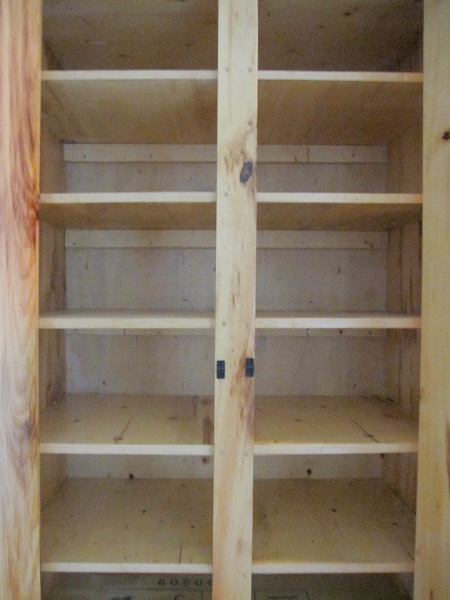
The Best Shelving for Your Preserves
Use a sturdy shelf for storage so you don’t find your canned goods in a broken heap on the floor.
Particleboard and MDF board are not designed to hold heavy loads and will warp and break. Use shelving made from solid wood boards with center support for the best results.
Metal or plastic shelves can also be used if they are rated to hold the weight you place on them.
Before purchasing shelving units or loading them up with jars, check to see what weight they are rated for and weigh the jars to see if you will be staying within those limits.
You’d be surprised at how much those jars weigh when you start piling them up! If you notice any of your storage shelves bowing or bending, remove your jars of food right away. You may attempt to add more support in the center of each shelf (cement blocks might do in a pinch) or replace them with something sturdier.
As an Amazon Associate, I earn a commission from qualifying purchases.

Tips for Storing Home-Canned Goods
Make sure those freshly processed jars are sealed properly before you whisk them away to the basement.
Metal lids are easy to check. If the lid moves up and down when you press on it, the jar did not seal properly and the food should be used or refrigerated promptly.
Tattler reusable lids are a bit trickier to check. You will need to remove the metal screw band and test the lid with your fingers. Sealed lids should remain firmly in place and those that did not seal properly will pull off.
After processing your jars of food, allow them to cool thoroughly. Then remove all screw bands and wash the jars and screw bands with warm soapy water to remove any juice or food that may have leaked from the jars during processing.
Dry the jars and bands, write the date and contents on the lid or on a label and store them in a cool, dark, dry place until you are ready to use them.
It is also best to store your home-canned foods in a single layer. Stacked jars are not as stable as a single layer and you don’t want your jars to fall and break!
As an Amazon Associate, I earn a commission from qualifying purchases.

Should You Leave the Screw Bands in Place?
You may store your canned goods with or without the metal screw bands in place.
I usually store my jars without the metal bands because the humidity in our basement is higher than I would like. I like to reuse the metal bands as many times as possible, so I try to keep them in a dry place.
You also don’t want to pull out a jar of peaches and find that the metal lid and screw bands are rusted together. Unscrewing really rusty bands can sometimes chip your glass jars.
However, if you move your jars around a lot and the storage area is dry, replace the metal screw bands to prevent chipping the jars or breaking the seal on your lids as you move them.
Just be absolutely sure those metal bands are clean and dry before you screw them back on. Any food or sticky juice left on the jars can mold and contaminate the food inside when you open the jar.
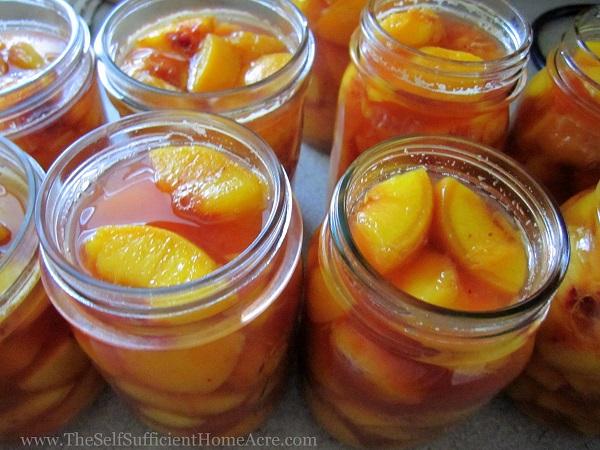
Don’t Take Chances with Your Food
With all of the work that goes into growing and preserving your own food, you don’t want to waste it. Make sure you follow these guidelines for properly storing home-canned goods and you’ll enjoy them all winter!
For more information on home canning, visit the National Center for Home Food Preservation.
Do you have any tips for storing home canned goods that I might have missed? Leave a comment!
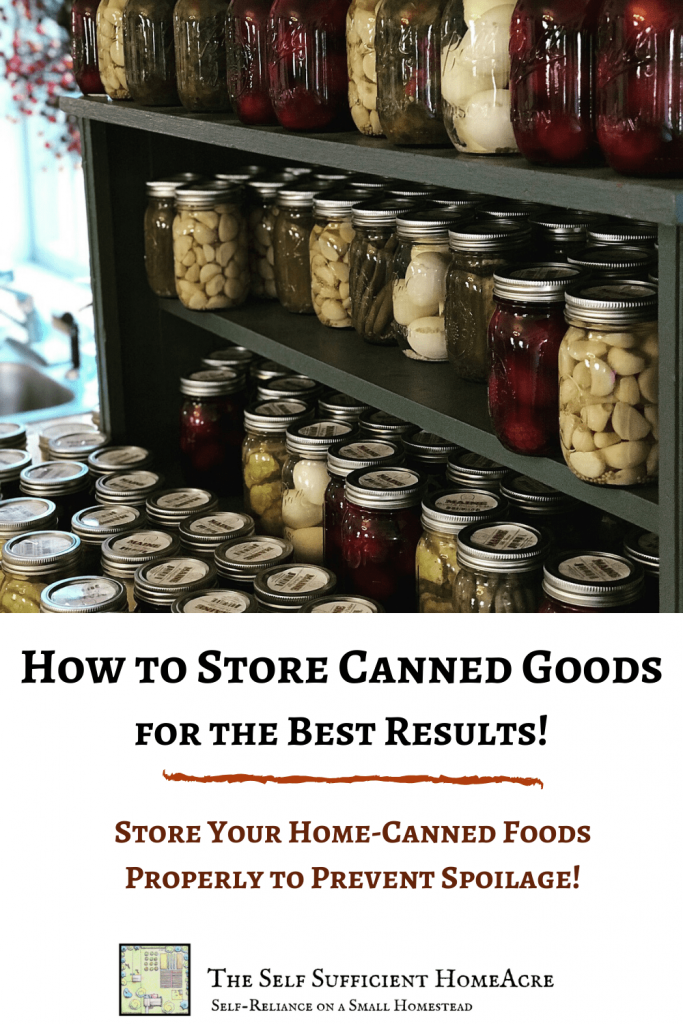

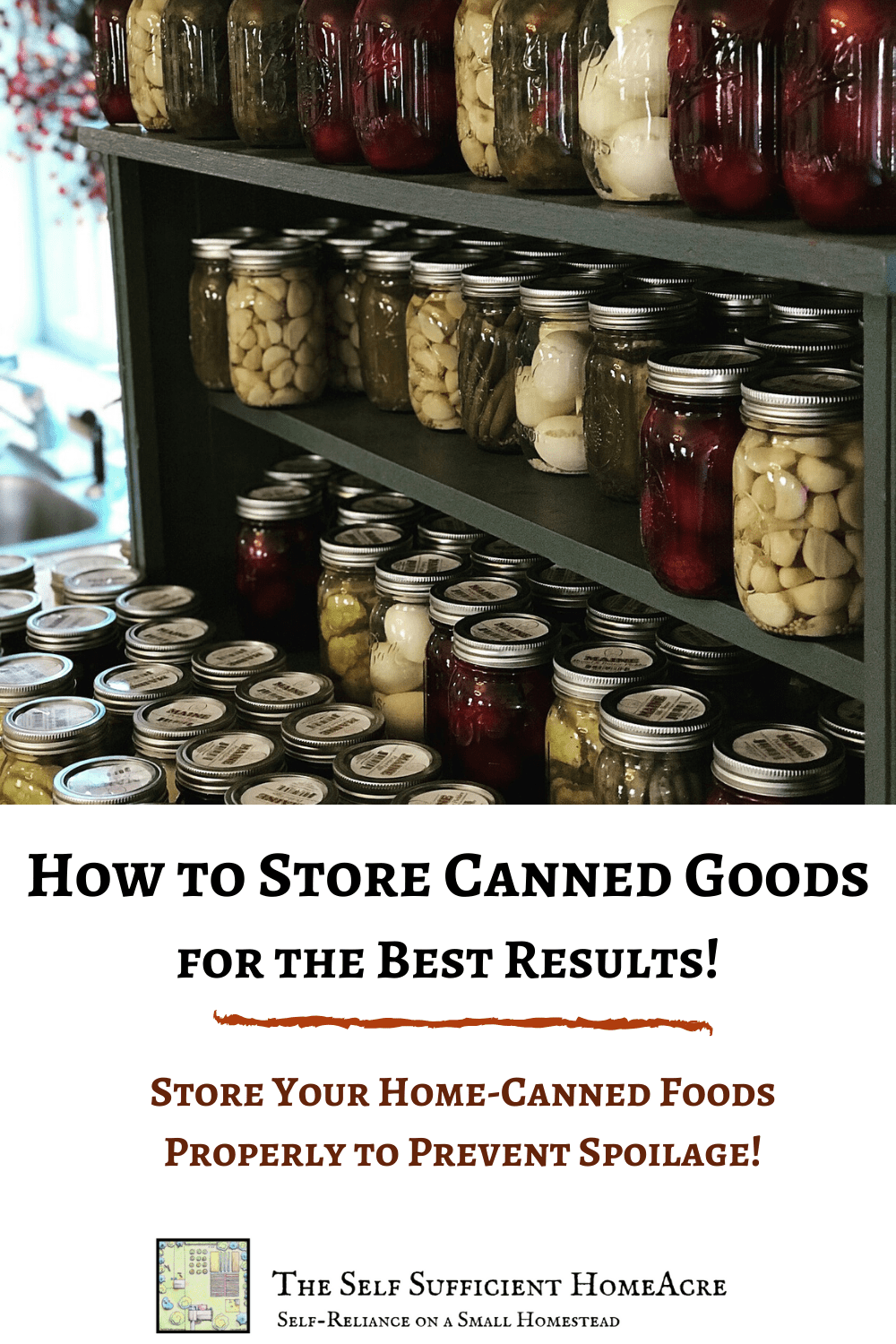


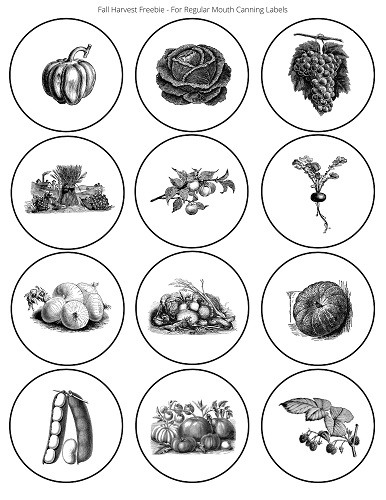
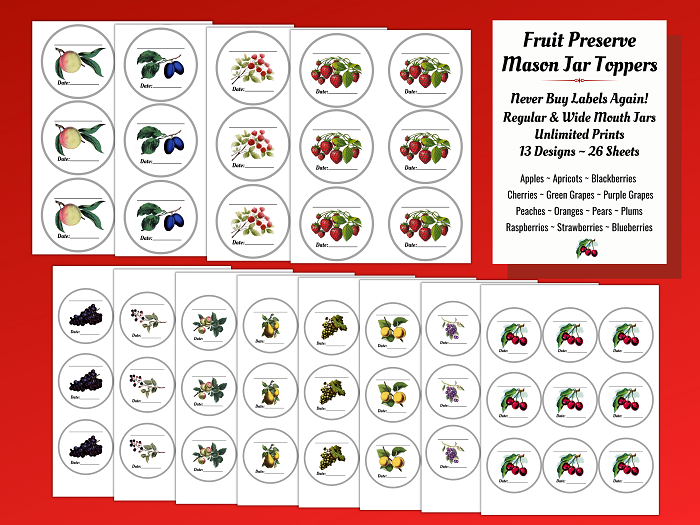


If I keep my canned goods in the garage, what would be the highest temperature that they could tolerate? I have a metal cabinet and/or shelves.
Hi Cheri,
Temperatures of 100 F or higher can damage canned goods (both purchased and home canned) but it is best to keep them below 85 F for the best quality. I hope this helps.
Hi, Lisa,
I’m glad you shared these tips. I have always stored my jars with the rings on, but sometimes they have become rusty. Now, with things so hard to come by, I will remove the bands to keep them in good condition. Once I get them in my pantry…(some sweet day).
I love your pantry full of good things. It is a nice feeling to have a stocked pantry, isn’t it?
Blessings, and thanks for hosting the Hop!
Laurie
Hi Laurie,
Humidity can cause a lot of problems in the pantry! Yes, I think it is a good idea to remove the bands if you are concerned about the rust. The screw bands will definitely last longer!
It’s a great feeling to stash away our harvest for the winter!
Hi! I live in north Florida about 20 miles from the Gulf-inland where temps are over 100, at times & high teens, at times. Have you ever stored in a resin made shed? What do you suggest to keep the temps & humidity inside of one safe for the jars?
Hi Tina,
I have never tried that and I think it might be too difficult to control the temperature and humidity in a resin shed, especially under those conditions. You would probably need to insulate the shed and run an air conditioner to keep the temps cool enough. If you have a underground storage space, that might be easier to keep cool. I hope this helps.
You should always remove the rings to prevent false seals. Jars with the rings on can become unsealed and reseal without you knowing. And never tighten a loose ring after the jar seals. It can break the seal.
Thanks for the info.
So the jars will stay sealed without rings even over time? How long will the food last if stored properly?
Hi Tina,
If you remove the screw on rings, you need to be a bit more careful about moving the jars around to be sure you don’t break the seal. It is recommended that most home-canned goods be used within one year, although many people keep it longer. I hope this helps… Lisa
Thank you for hosting! This is what I featured the week of 10-5-to 10-9-2020 on my blog. On Tuesday was Paleo Banana Bread. Wednesday was Cranberry Cream Cheese Loaf. Thursday was Apple Cider Donut No Bake Cheesecake. And winding up this week was Pork Loin With a Baked Apple Sauce. Enjoy!
Thanks so much for sharing your goodies with us, Marilyn!
Thank you so much for featuring my vanilla extract recipe!
I also think this post is great and really informative. Your canning stash is amazing! I usually just can a few cases of jam or jelly and some pickled here or there. We haven’t moved onto any pressure canning yet although I found a pressure canner a couple years ago at a garage sale. I’m nervous about that next step, but would love a shelf covered in jars of canned beans, etc!
Thank you, Rachael! I’m happy to share your post! Thanks for sharing with us!
Lisa,
Thanks so much for hosting each week!! It is greatly appreciated!! Stay safe, healthy and happy!!
Hugs,
Deb
Hi Deb! Thank you for sharing!
I have frozen up until this point. Canning is on my ‘to do’ tackle list for 2021! Thank you for the info…
Hi Jodie!
Best wishes with your canning adventures!
I have some canned food from the grocery store that had been frozen and then I put them in the cabinet and they thawed out. Can I still eat them.
Hi Peggy,
I found the following information on a Cooperative Extension website…
“Check the seams carefully on commercially canned foods that have been frozen to make sure there are no openings. If the seal is intact, the food is safe to eat, even after it thaws. … If a can is bulged–and still frozen–keep it frozen in the freezer until ready to use, then thaw in the refrigerator.”
If I use metal shelves to store (store-bought) canned goods in my basement, do you recommend lining the shelf with some material, or just placing the cans on the metal shelves (then stacking the cans one on top of another)? Thanks for your feedback!
Hi Rich,
I think that either way will work just fine. If you have a lot of humidity in your basement, watch to make sure that the canned goods don’t get rusty. If this is the case, you may want to put some sort of liner down on the shelves (vinyl liners like the ones used in kitchen cabinets work well) and don’t store more than a few months worth of food at a time. A dehumidifier would be a good idea, if you can plug one in.
Be sure to rotate your canned goods so you are always using up the oldest cans first. If some cans do get rusty, they should still be okay to use as long as the seal hasn’t been compromised. When you use a can opener to open them, listen for the sound of the vacuum seal being broken to be sure that the food is still safe to eat.
If you are planning to use this storage method as your emergency preparedness plans, the dehumidifier can be used unless power goes out. But you may want to consider some of the emergency storage foods in mylar bags with CO2 absorbers in them. These won’t rust and they keep out moisture.
One other consideration is how much weight the metal shelves can hold. If you are purchasing new ones, they should have a weight limit listed on then packaging. Weigh your canned goods to make sure that you don’t over do it and cause the shelves to collapse. Canned goods stacked up get pretty heavy and I some people make the mistake of putting too much on a shelf and then hearing a crash in the middle of the night…not good!
I hope this is helpful.
I live in a mobile home. have vents in all rooms but the spare room there is hardly any heat but just a little mold have a full size basement and dehumidifier what would work best in storing canned goods?
Hi Melissa,
As long as you don’t store them where they are freezing or hot, or have hot air blowing on them, they should be fine. I store most of mine in the basement, and it does get a little too humid there, but they have all been fine. Considering your choices, I would most likely choose the basement. Best wishes!
I live in a single wide mobile home and my only available storage space is a small cupboard between my stove and fridge…will this work?…
Hi Diana,
When space is limited, you do what you need to store your extras! As long as the cupboard isn’t overly warm, it will work fine. You might also want to check to see if you can store anything under beds (using those roll out storage bins), in closets (can you put a storage bin on the floor and put shoes on top?), or look into some of the space saving racks for the inside of your kitchen cupboard doors.
Best wishes! Thanks for stopping by!
I am fairly sure the cabinet stays relatively cool except when I bake cookies en mass for Christmas…unfortunately all closets and under beds are currently in use for other storage…would putting, like, a fridge thermometer in there and just keeping an eye on it work?…what is the best temp range?…
Hi Dianna,
I understand completely! I think that you are fine with the canned goods there. You just don’t want really warm temps. Room temp is fine. Too warm for very long, like in the 90’s maybe, would cause the color to brown. Just use up in a year for best results!
Thanks for sharing!
I have my canned green bean, tomatoes, soups, etc. stored in my garage. The temperature will be down to 4 degrees tonight. I am not sure how low the temperature will get out there. Can I put them in my spare bedroom, if it is cool in there. I can turn off the heat and store them in my closet???
Hi!
Yes…I would definitely move them indoors to a spot where they won’t freeze. A cool closet would be great 🙂 Best wishes and let me know how it all works out.
I do not have the cupboard space to store all my jars, I have stored in my garage fridge, it it okay to store them there for the winter?
Hi Denise,
If the temps in your garage fridge will go below freezing, you will need to find a different spot for them. Freezing will cause the jars to crack…not good! Best wishes!
We have a Yankee basement which is unheated and not connected to the main part of the house. Would it be safe to store cans down there?
Hi Elizabeth,
If the temperatures stay above freezing, you can store them there. But if it ever dips down below freezing, you could lose any cans or jars. You might want to buy one of those remote thermometers that records the low and high temperatures…then keep track during the extreme heat and cold to see what the temps are like. Best wishes!
This is great! Thanks for sharing; I’ll be pinning this for later! We recently moved from a small 2nd-floor apartment in a downtown area to a spacious house on the outskirts of town with lots of fabulous potential garden spaces!
Your canning cabinet is a beautiful sight. 🙂
~Lisha
Congratulations on your move, Lisha! I wish you many years of happy gardening in the new place 🙂 Thanks for pinning!
I don’t have a basement so we use a spare bedroom. I bought a thrift store dresser and removed the drawers, painted it and it’s my canning cabinet. Photos on my blogs. I always store mine with the rings on.
Great ideas, Nancy! Thanks for sharing them with us 🙂
Wow, your canning cupboard looks fabulous! I don’t think I will ever be that organized, though I will certainly try to follow your example. Thanks for the valuable information! I didn’t see any labels on your jars – so do you label the lids?
Hi Vickie,
Thank you 🙂 I owe the organization to my Dad! I usually write the contents and date on the top of the metal lids in permanent marker. If I use my Tattler lids, I put masking tape or a label on the side of the jar with the contents marked on it. I haven’t had the best luck with my Tattler lids and don’t use them as much as I hoped I would.
all wonderful ideas, however I have no basement or non heated storage space. 🙁 I would love to get into canning, but am reluctant because of the lack of space to store items. Any other ideas?
Hi Faith,
As long as it isn’t real warm in the main living area of your home, you should be able to store your canned goods in the kitchen, spare bedroom, under beds, in closets, etc. You can also try dehydrating extra food and storing in the fridge or freezer for best results.
Best wishes!
Very informative post. this information is invaluable to those new to canning. The storage is as important as the steps needed to can the fresh produce. thanks!
Thank you, Janet! You’re so right…improperly stored foods can go bad and waste your time, money, and food.
I love that cupboard since the first time you posted it. I remember when i was younger and first moved into the house we are in now, I was putting my canned goods (from Mama) under one of my cabinets in the kitchen. I kept finding a jar here or there losing it’s seal. I found that the floor vent in the kitchen came up by that cabinet and my jars were getting to warm and losing their seal. I had to swap my cabinets around to fix that. Of course now I have my lovely pantry for my canned goodies.
Thank you Ann! Sorry to hear that you lost so many jars of home canned goodies 🙁
Unfortunately, my tiny container garden didn’t give me much to even enjoy this year! Of ALL things, only the herbs did well. How strange.
Anyhoo. I devoured this post for next years REAL garden. Thanks so much for all the useful tips!!
Hi Terri,
I hope you have been able to dry some of those wonderful herbs for this winter 🙂 I’m sure that next year you’ll have much better luck with all those wonderful veggies you want to grow. You know, with all the work going on around your new place this spring, I’m amazed you were able to get a container garden started…you rock!
Excellent post – very timely! I love the canning cupboard your dad made for you. How smart to make the shelves various heights to fit all jars from half pints to quarts! Saves the temptation of stacking, too! Thank you for sharing.
Thank you Meredith! My Dad is a very talented guy 🙂 I’m so glad to have some of his creations in my house!